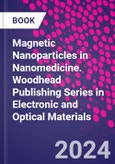Magnetic Nanoparticles in Nanomedicine provides readers with the fundamental theories and principles of magnetic materials, the synthesis and surface functionalization strategies of MNPs, and the standard techniques for characterizing physicochemical properties of MNPs. Other sections review MNP-based therapies such as magnetic hyperthermia therapy, drug/gene delivery, and magnetic neurostimulation and cover MNP-based in vitro and in vivo disease diagnosis, respectively, including techniques such as magnetoresistive (MR), nuclear magnetic resonance (NMR), magnetic particle spectroscopy (MPS) biosensing platforms, magnetic resonance imaging (MRI), and magnetic particle imaging (MPI).
Final chapters address biocompatibility and safety issues in applying MNPs to in vivo biomedical applications, including coverage of the toxicity of MNPs to human tissues, the immune responses of the human body to these particles, as well as blood circulation time of MNPs.
Please Note: This is an On Demand product, delivery may take up to 11 working days after payment has been received.
Table of Contents
Section I. Magnetic Nanoparticles (MNPs): Synthesis, Functionalization and Characterization1. Basics of Magnetic Materials and Magnetism
2. Micromagnetic Simulation
3. Current Methods for Synthesis and Surface Modifications of MNPs
4. Current Characterization Techniques for MNPs
Section II. MNPs for Therapy
5. MNPs for Hyperthermia Therapy
6. MNPs for Drug/Gene Delivery
7. MNPs for Neurostimulation
Section III. MNPs for In Vitro Disease Diagnosis
8. Magnetoresistive (MR) Biosensor
9. Nuclear magnetic resonance (NMR) Biosensor
10. Magnetic Particle Spectroscopy (MPS) Biosensor
11. Magnetic Separation Assisted Diagnosis
Section IV. MNPs for In Vivo Disease Diagnostic Imaging
12. Magnetic Resonance Imaging (MRI)
13. Magnetic Particle Imaging (MPI)
Section V. Biocompatibility and Immunotoxicity of MNPs
14. Immunotoxicity and Safety Considerations
?????15. Cellular Uptake and Blood Circulation Time of MNPs








